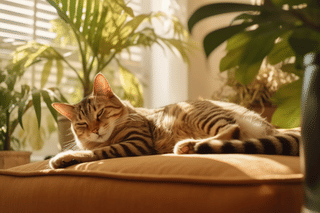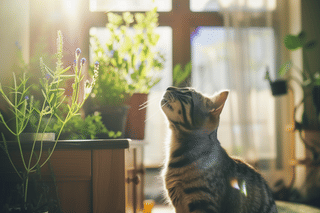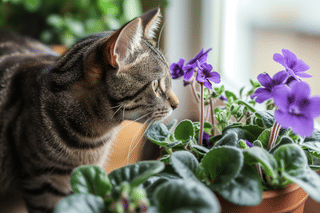Checklist: What do you do when your pet has eaten your plant?
Discover how to keep your pets safe with this quick and easy guide on what to do when your pet eats a plant. Learn essential steps to identify toxic plants, monitor symptoms, and effectively train your pets to avoid plants, ensuring their health and safety.
It's the biggest fear of every pet owner: Your pet has chewed on a plant. Do you know what to do next? It might not always be as easy as you think, so let's figure that out in this quick plant guide!
We'll go through a few short steps to figure out what you should do to help your pet.
Step 1: Figure out if the plant is toxic to pets
The first thing you should do is to figure out if the plant your pet has eaten is toxic or completely safe for your pet. If the plant is completely safe, there is no problem, just move your plant or make it inaccessible for your pet in another way. This way they won't chew on it again.
Step 2: Check how much your pet has eaten
If the eaten plant is toxic to your pet, the next step is to figure out how much your pet has eaten. Some plants are "only" mildly toxic to your pets, so they might get a bit of an upset stomach, but nothing life-threatening. If your pet is acting like it's completely fine, even after some time has passed (don't wait more than 15 minutes), it might still be a good idea to give your veterinarian a quick call to ask for advice.
Step 3: Watch out for these symptoms
Most toxic plants contain particles that will start to irritate your pet's gums, teeth, and stomach. So if you're unsure whether your pet has eaten too much of the plant to cause problems, be extra mindful of the following symptoms:
- Vomiting
- Not wanting to eat
- Scratching at their mouth
- Sneezing
- Choking or gagging
- Coughing
If you see any of these symptoms, no matter how little they might be, call your veterinarian right away. Perhaps it's nothing serious, but it's better to be safe than sorry in this case.
If you're in doubt, always call your veterinarian! It's better to call too much than too late.
Step 4: Move your (toxic) plants out of reach of your pets
Moving your plants out of reach is not really a next step, but rather to prevent your pets from chewing on your plants again. Sometimes it's not possible to keep your plant away from your pet, or the other way around, so then you'll need to get a little creative with training your pets.
Step 5: Train your pet (even cats) to stay away from your plants
Pet love plants! They love the texture, the way it moves, and they just have to touch it, especially when they're bored. So, if you can safely bring your cat outside or to a room without any plants, do so. If that's not an option, you'll have to train your pets to stay away from your plants. This can take a while, especially for cats.
I've trained my cats by consistently using a spray bottle and physically pushing them away from plants for 3 to 6 months. Cats are very stubborn, but it was worth it: they're no longer interested in eating the plant. They'll lay next to it, but never actually touch it. Dogs are much easier to train, so it'll take a shorter time.
Thank you for reading this post! I hope it helps you to keep your plants healthy and beautiful! If you're looking for more guides on specific plants, you can always request a plant guide to get a guide for the plant you have trouble with.
Test your plant care knowledge
Quiz completed!
Want to learn more? Sign up for my newsletter to receive free tips in your inbox!
Sign up now!









